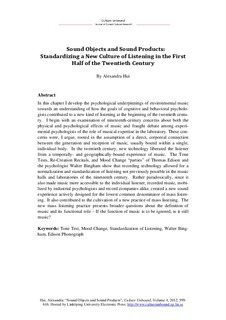| dc.contributor.author | Hui, Alexandra | |
| dc.date.accessioned | 2017-06-30T07:39:51Z | |
| dc.date.available | 2017-06-30T07:39:51Z | |
| dc.date.issued | 2012 | |
| dc.identifier.issn | 2000-1525 | |
| dc.identifier.uri | http://hdl.handle.net/11250/2447418 | |
| dc.description.abstract | In this chapter I develop the psychological underpinnings of environmental music
towards an understanding of how the goals of cognitive and behavioral psychologists
contributed to a new kind of listening at the beginning of the twentieth century.
I begin with an examination of nineteenth-century concerns about both the
physical and psychological effects of music and fraught debate among experimental
psychologists of the role of musical expertise in the laboratory. These concerns
were, I argue, rooted in the assumption of a direct, corporeal connection
between the generation and reception of music, usually bound within a single,
individual body. In the twentieth century, new technology liberated the listener
from a temporally- and geographically-bound experience of music. The Tone
Tests, Re-Creation Recitals, and Mood Change “parties” of Thomas Edison and
the psychologist Walter Bingham show that recording technology allowed for a
normalization and standardization of listening not previously possible in the music
halls and laboratories of the nineteenth century. Rather paradoxically, since it
also made music more accessible to the individual listener, recorded music, mobilized
by industrial psychologists and record companies alike, created a new sound
experience actively designed for the lowest common denominator of mass listening.
It also contributed to the cultivation of a new practice of mass listening. The
new mass listening practice presents broader questions about the definition of
music and its functional role – If the function of music is to be ignored, is it still
music? | nb_NO |
| dc.language.iso | eng | nb_NO |
| dc.publisher | Linköping University Electronic Press | nb_NO |
| dc.rights | Navngivelse-Ikkekommersiell 4.0 Internasjonal | * |
| dc.rights.uri | http://creativecommons.org/licenses/by-nc/4.0/deed.no | * |
| dc.subject | Tone Test, Mood Change, Standardization of Listening, Walter Bingham, Edison Phonograph | nb_NO |
| dc.title | Sound Objects and Sound Products: Standardizing a New Culture of Listening in the First Half of the Twentieth Century | nb_NO |
| dc.type | Journal article | nb_NO |
| dc.type | Peer reviewed | nb_NO |
| dc.description.version | publishedVersion | nb_NO |
| dc.source.pagenumber | 599-616 | nb_NO |
| dc.source.volume | 4 | nb_NO |
| dc.relation.project | NFR 220756 | |

